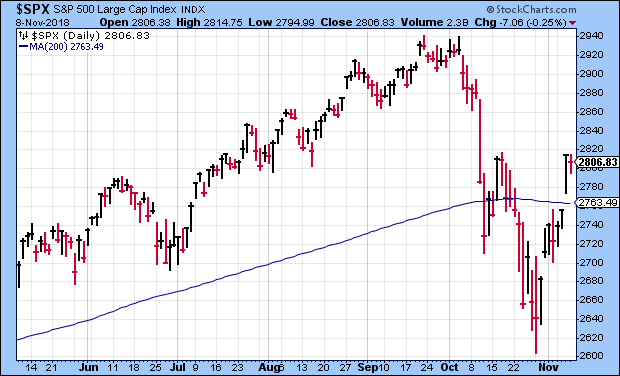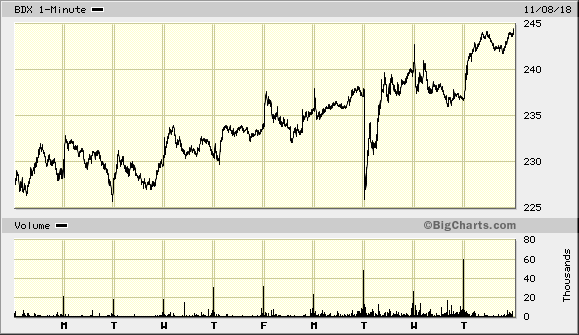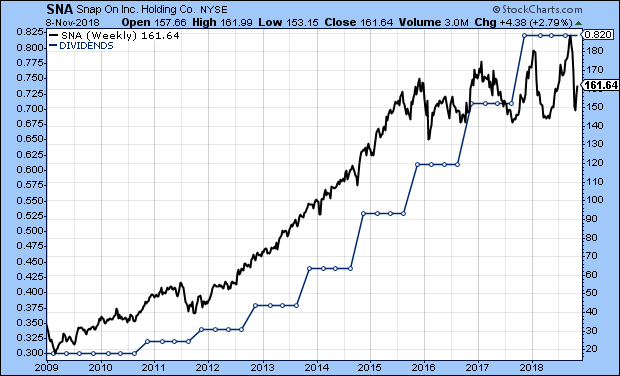-
Morning News: November 12, 2018
Posted by Eddy Elfenbein on November 12th, 2018 at 7:12 amHow an Intelligence Expert Helps Wall Street Mavens Think Smarter
This Is How the Unicorn Bubble Will Burst
This Is the Single Most Meaningless Shopping Event
If OPEC Thought Its Job Was Done, 2019 Will Be a Nasty Shock
Oil Pucks and Pellets; Canada Eyes New Ways to Move Stranded Crude
How Trump’s Trade War Went From 18 Products to 10,000
No Joke: Donald Trump Once Proposed a Tax-the-Rich Strategy to Save Social Security
SoftBank Targets $20 Billion IPO for Japanese Mobile Unit
How One Family Built $8 Billion Startup Far From Silicon Valley
Veritas Capital, Elliott Clinch $5.5 Billion Acquisition of Athenahealth
Diageo Sells Seagram’s and Sambuca Brands
Vista Reaches Deal to Buy Software Firm Apptio for $1.94 Billion
Ben Carlson: Trends & Time Lapses
Jeff Miller: Market Storm Averted?
Be sure to follow me on Twitter.
-
In Flanders Fields
Posted by Eddy Elfenbein on November 11th, 2018 at 11:53 amIn Flanders fields the poppies blow
Between the crosses, row on row,
That mark our place; and in the sky
The larks, still bravely singing, fly
Scarce heard amid the guns below.We are the Dead. Short days ago
We lived, felt dawn, saw sunset glow,
Loved and were loved, and now we lie,
In Flanders fields.Take up our quarrel with the foe:
To you from failing hands we throw
The torch; be yours to hold it high.
If ye break faith with us who die
We shall not sleep, though poppies grow
In Flanders fields.By Lieutenant Colonel John McCrae, MD (1872-1918)
Canadian Army -
CWS Market Review – November 9, 2018
Posted by Eddy Elfenbein on November 9th, 2018 at 7:08 am“The path is smooth that leadeth on to danger.” – William Shakespeare, Venus and Adonis
On Tuesday, Americans went to the polls and they voted for gridlock. Or more accurately, the Democrats won control of the House of Representatives while the Republicans increased their Senate majority.
What does this mean for us as investors? Eh…not much, really. Sure, I know how partisans like to jump and holler, but the long-term impact on the markets is pretty small. Historically, bull markets have done just fine while there’s been gridlock in Washington. If anything, Wall Street seems pleased that the uncertainty of the election has passed.
It’s true that things have improved recently for the stock market. Before Thursday’s pullback, the S&P 500 rallied six times in seven days. Since October 29, the index has added 6.3%. That’s a nice change from Red October. Measuring from the closing high to the closing low, the S&P 500 has already gained back most of what it lost.
Then on Wednesday, the S&P 500 crossed the crucial threshold by closing above its 200-day moving average (the blue line in the chart above). The Volatility Index is now back to its lowest levels in a month, but I think this may be a false pause. In this issue, I’ll lay out my reasons. We also had our final two Buy List earnings reports for this cycle. I’ll break it all down for you. Plus, we got a nice 16% dividend hike from Snap-on. But first, let’s look at the other election this week, the 9-0 vote at the Fed to leave interest rates alone.
The Fed Pauses but More Rate Hikes Are Coming
The Federal Reserve met on Tuesday and Wednesday of this week. As expected, the central bank decided to forgo an interest-rate hike, but another one is probably coming next month. The Fed has already raised rates three times this year and eight times this cycle. The current range for Fed funds is 2% to 2.25%. Interestingly, that brings short-term rates to nearly even with inflation.
The Fed’s policy statement was refreshingly optimistic. (I should explain that central bankers are trained to see the downside of every event. They’re not happy unless the world is coming to an end, so even a little optimism is noteworthy.) Specifically, the Fed said “the labor market has continued to strengthen, and that economic activity has been rising at a strong rate.” The Fed also noted that household spending “has continued to grow strongly.” In Fedspeak, that means the economy is on fleek.
The Fed didn’t address the housing market directly, but that could be a concern. The stock market’s freak-out during October was largely centered on housing. I think the market was overdoing it, and we’re starting to see some effects of that. On our Buy List, you’ll note the sharp rebound in stocks like Sherwin-Williams (SHW). SHW has risen the last eight days in a row for a gain of 13.2%. In a bit, I’ll cover the good earnings report from CBPX, our wallboard stock. It plunged 30% last month.
While the housing panic was way overdone, I still believe we should be cautious about the market. In fact, I think it’s very likely the market will soon see volatility heat up and share prices fall. I don’t want to alarm you. I’m not predicting the Apocalypse (sorry, central bankers). Rather, I see a mild autumn swoon.
What has me concerned is next week’s inflation report. Given the slight rise in wages we saw in October, it’s very likely some cost pressures have made their way into consumer prices. It’s not much, but it’s a change from what we’ve seen. If I know Wall Street, the market—particularly the bond market—will overreact. That’s what it’s paid to do. Over the past week, the market has recovered too quickly for my liking.
Right now, the market expects the Fed to raise rates in December, then again in March. After that, the market expects the Fed to take a six-month break. I’m not so sure about that. If next week’s inflation report comes in hot, then the Fed may be pressured to step up its rate increases.
The good news is that the selloff gave us a lot of good stocks at good prices. In fact, a few of our Buy List stocks like Hormel Foods, Church & Dwight, Ross Stores and Intercontinental Exchange have all broken out to new highs.
For now, I encourage you to remain calm. There are plenty of good stocks out there. Some stocks on our Buy List that look especially good are Moody’s (MCO), which is down from an earnings miss, Cognizant Technology Solutions (CTSH), which looks good below $75 per share, and Torchmark (TMK), which is a nice buy if you can snag it below $88 per share. Now let’s look at this week’s earnings reports.
Earnings from Becton, Dickinson and Continental Building
We had our final two Buy List earnings report for this earnings season this week. On Tuesday, Becton, Dickinson (BDX) reported fiscal Q4 earnings of $2.93 per share. That matched Wall Street’s estimates, and it was also a nice increase from $2.40 per share one year ago. This was a big year for BDX because it was the first year they’ve operated after absorbing CR Bard. For the year, Becton made $11.01 per share. Adjusting for the acquisition, revenues were up 5.8% for the fiscal year.
“Fiscal 2018 was a historic year for BD with the successful completion of the acquisition of C. R. Bard. We are extremely proud of our strong fourth quarter and fiscal year results, which demonstrate how agile we can be as an organization while executing concurrently on two transformative acquisitions,” said Vincent A. Forlenza, Chairman and CEO. “We enter fiscal 2019 with continued strong momentum and confidence in our ability to execute on our strategy, deliver on our commitments and create value for our shareholders.”
What I really like about Becton is that they raised their earnings outlook during the entire year. Let’s look at some history. In fiscal 2017, they made $9.48 per share. Last November, the company originally pegged EPS for FY 2018 at $10.55 to $10.65. In February, they bumped the range up to $10.85 to $11 per share. In May, they raised the range again to $10.90 to $11.05 per share. Then in August, it went to $10.95 to $11.05 per share. Ultimately, they made $11.01 per share. I love watching those steady increases.
What about 2019? For the current fiscal year, BDX expects earnings between $12.05 and $12.15 per share. They’re looking for adjusted revenue to rise by 5% to 6%.
On Tuesday morning, shares of BDX plunged. I have no idea why. The report looked just fine to me, but traders gonna trade. Sure enough, BDX rallied back and closed higher by 1.4% by the closing bell. Becton, Dickinson remains a buy up to $260 per share.
Then on Thursday, we got the earnings report from Continental Building Products (CBPX). I’ve been anticipating this one. In October, the stock got a super-atomic wedgie. It plunged 30% on no company-specific news. Traders were freaking about housing, and anything remotely related to that got clobbered. As a wallboard company, Continental got caught in the crossfire.
After the bell on Thursday, Continental said they made 51 cents per share for their third quarter. That beat estimates by three cents per share. The details of the report look pretty good. Net sales increased by 12.6% to $131.2 million. Also, gross margin increased to 28.1% compared to 24.5% last year.
“We executed strong operational and financial results in the quarter with a 76% increase in earnings per share and significant operating cash flow driven by higher net sales and our highly efficient low cost operations,” stated Jay Bachmann, President and Chief Executive Officer. “We achieved a 21% increase in EBITDA and a 360 basis point improvement in gross margin, marking the fifth straight quarter that we have expanded gross margin. This overall improvement reflects our relentless focus on our Bison Way continuous improvement effort as our associates work together to streamline our operations and elevate our service to customers. We are especially pleased to deliver these results against a backdrop of continuing inflationary pressures in freight, labor and raw materials.”
Continental doesn’t give EPS guidance, but they do offer ranges for a few operating metrics. Roughly, it probably translates to 60 cents per share for Q4 and $2 for the entire year. That’s pretty much what I had been expecting before the stock’s recent nosedive. I like CBPX and I’m willing to stick with them, but I’m lowering my Buy Below price to $33 per share to reflect the selloff.
That’s the end of the third-quarter earnings season for us, but on our Buy List, we have three stocks with quarters ending in October. That means they’re due to report earnings soon. Ross Stores (ROST) and Hormel Foods (HRL) will report on November 20, and JM Smucker (SJM) will report on November 28. I’m expecting another dividend increase from Hormel. It’s easy to predict these things when the company has raised its dividend every year for the last 52 years. I’ll preview these stocks in next week’s issue.
Snap-on Boosts Dividend by 16%
After the close on Thursday, Snap-on (SNA) gave its shareholders a nice raise. The company is raising its quarterly dividend from 82 to 95 cents per share. That’s an increase of nearly 16%. This is Snap-on’s ninth-straight annual increase. Based on the stock’s closing price, the new dividend yields 2.35%. Based on next year’s estimate, the dividend works out to a payout ratio of about 30%.
This dividend hike is especially good to see after the stock got dinged nearly 10% a few weeks ago after the earnings report. The earnings were good, but the top-line number was weak. The new dividend is payable December 10 to shareholders of record on November 20. Snap-on is a buy up to $167 per share.
Before I go, I also wanted to lower our Buy Below on Cerner (CERN) to $63 per share. I still like Cerner, but I wanted to adjust the price to reflect the drop after the last earnings report.
That’s all for now. Monday is when Veterans Day is observed in the United States, but the stock market will be open. (Sunday will be the 100th anniversary of the end of the First World War.) On Wednesday, the CPI for October will be released. So far, inflation has been fairly tame, but I think there’s a chance we’ll see evidence of higher prices. On Thursday, the retail sales report for October comes out. Then on Friday, the industrial production report is due to be released. Be sure to keep checking the blog for daily updates. I’ll have more market analysis for you in the next issue of CWS Market Review!
– Eddy
Syndication Partners
I’ve teamed up with Investors Alley to feature some of their content. I think they have really good stuff. Check it out!
It Is Time To Get Bullish On Stocks?
Volatility Will Normalize and Here’s How To Profit When It Happens
-
Morning News: November 9, 2018
Posted by Eddy Elfenbein on November 9th, 2018 at 7:03 amSpenders or Thrifters: As Singles’ Day Nears, Are China’s Shoppers About to Drop?
Trump’s Tariffs Have Fully Kicked In—Yet China’s Exports Grow
Russia Clashes With Western Oil Buyers Over New Deals as Sanctions
Oil Teeters Near Record Losing Streak After Entering Bear Market
What Bond Carnage? Pimco Boosts Allianz With $11 Billion Inflow
SEC to Review Corporate Democracy Rules Risking Investor Clash
Judge Blocks the Disputed Keystone XL Pipeline In A Setback For Trump’s Energy Agenda
FDA Plans to Sharply Restrict Sales of Flavored E-Cigarettes
Why Ford Motor Company Is Scooting Into Micro-Mobility
VW Plans to Sell Electric Tesla Rival for Less Than $23,000
Google Overhauls Sexual Misconduct Policy After Employee Walkout
Bitcoin Pioneer Who Gave Away Over $100 Million Has No Regrets
Roger Nusbaum: Portfolio Update
Jeff Miller: Boost Your General Mills Dividend Yield
Ben Carlson: Things You See During Every Market Correction
Be sure to follow me on Twitter.
-
Today’s Fed Policy Statement
Posted by Eddy Elfenbein on November 8th, 2018 at 2:03 pmInformation received since the Federal Open Market Committee met in September indicates that the labor market has continued to strengthen and that economic activity has been rising at a strong rate. Job gains have been strong, on average, in recent months, and the unemployment rate has declined. Household spending has continued to grow strongly, while growth of business fixed investment has moderated from its rapid pace earlier in the year. On a 12-month basis, both overall inflation and inflation for items other than food and energy remain near 2 percent. Indicators of longer-term inflation expectations are little changed, on balance.
Consistent with its statutory mandate, the Committee seeks to foster maximum employment and price stability. The Committee expects that further gradual increases in the target range for the federal funds rate will be consistent with sustained expansion of economic activity, strong labor market conditions, and inflation near the Committee’s symmetric 2 percent objective over the medium term. Risks to the economic outlook appear roughly balanced.
In view of realized and expected labor market conditions and inflation, the Committee decided to maintain the target range for the federal funds rate at 2 to 2-1/4 percent.
In determining the timing and size of future adjustments to the target range for the federal funds rate, the Committee will assess realized and expected economic conditions relative to its maximum employment objective and its symmetric 2 percent inflation objective. This assessment will take into account a wide range of information, including measures of labor market conditions, indicators of inflation pressures and inflation expectations, and readings on financial and international developments.
Voting for the FOMC monetary policy action were: Jerome H. Powell, Chairman; John C. Williams, Vice Chairman; Thomas I. Barkin; Raphael W. Bostic; Lael Brainard; Richard H. Clarida; Mary C. Daly; Loretta J. Mester; and Randal K. Quarles.
-
Q3 2018 Earnings Calendar
Posted by Eddy Elfenbein on November 8th, 2018 at 9:10 amEarnings season is winding down with 20 of our 25 Buy List stocks now having reported Q3 earnings. Here’s a list of reporting dates, Wall Street’s consensus estimates and actual reported results.




 Eddy Elfenbein is a Washington, DC-based speaker, portfolio manager and editor of the blog Crossing Wall Street. His
Eddy Elfenbein is a Washington, DC-based speaker, portfolio manager and editor of the blog Crossing Wall Street. His